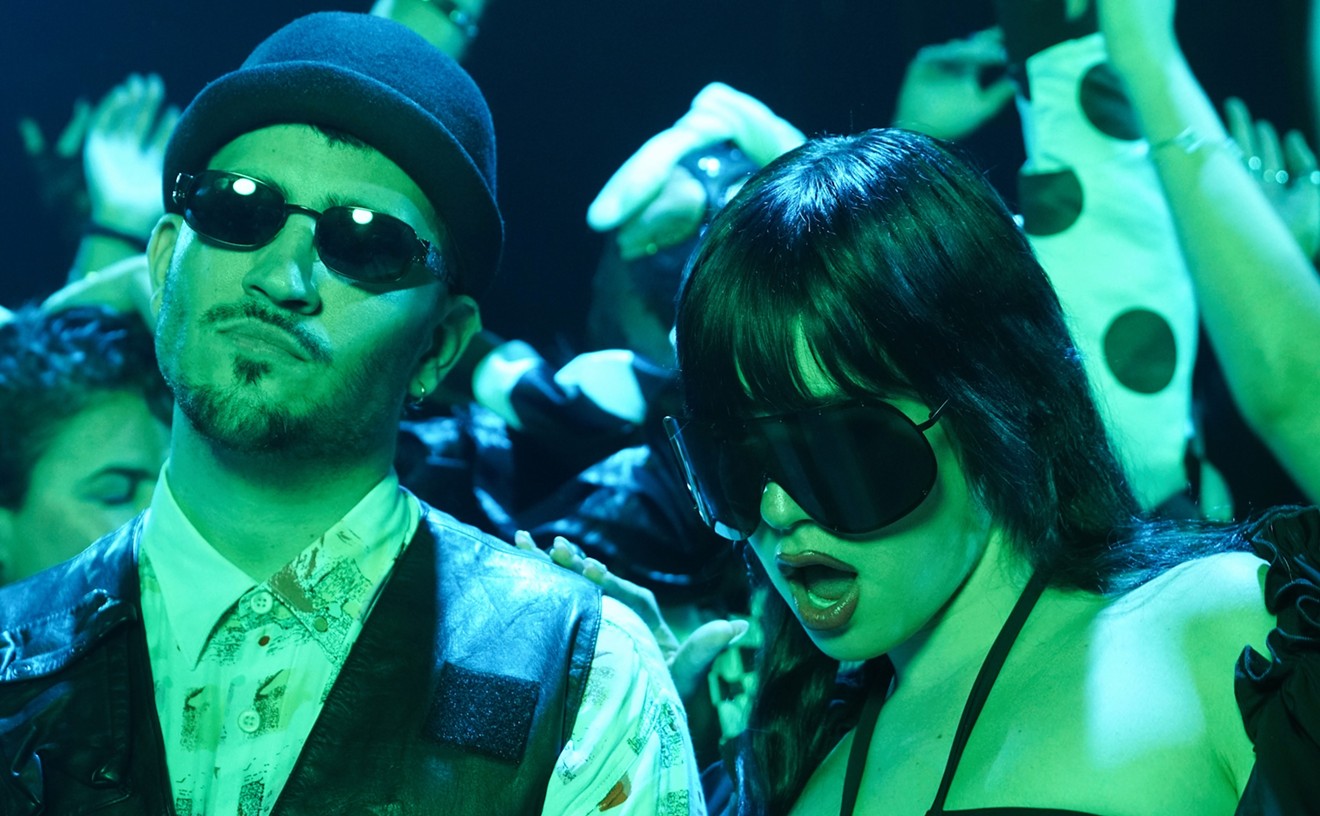Five Best Goth Rock Bands of All Time
Let’s make one thing clear about this list: the only goth bands that matter were those at the forefront of this short-lived scene in England. Everything after the bands listed and explored below were some sort of rip-off ... excluding one exception (it's called cognitive dissonance, humor me ... it's...
April 16, 2015
[
{
"name": "Air - MediumRectangle - Inline Content - Mobile Display Size",
"component": "19274298",
"insertPoint": "2",
"requiredCountToDisplay": "2"
},{
"name": "Editor Picks",
"component": "17482312",
"insertPoint": "4",
"requiredCountToDisplay": "1"
},{
"name": "Inline Links",
"component": "18711090",
"insertPoint": "8th",
"startingPoint": 8,
"requiredCountToDisplay": "7",
"maxInsertions": 25
},{
"name": "Air - MediumRectangle - Combo - Inline Content",
"component": "17482310",
"insertPoint": "8th",
"startingPoint": 8,
"requiredCountToDisplay": "7",
"maxInsertions": 25
},{
"name": "Inline Links",
"component": "18711090",
"insertPoint": "8th",
"startingPoint": 12,
"requiredCountToDisplay": "11",
"maxInsertions": 25
},{
"name": "Air - Leaderboard Tower - Combo - Inline Content",
"component": "17482313",
"insertPoint": "8th",
"startingPoint": 12,
"requiredCountToDisplay": "11",
"maxInsertions": 25
}
]
Let’s make one thing clear about this list: the only goth bands that matter were those at the forefront of this short-lived scene in England. Everything after the bands listed and explored below were some sort of rip-off ... excluding one exception (it's called cognitive dissonance, humor me ... it's also kinda genuinely goth).
Most of the bands noted below arose from England's post-punk scene in the late 1970s and evolved into something else. All feature literate lyrics that reference profound ideas from the mystical to the existential. Many wore early English rock influences clearly on their sleaves, like punk and glam rock, but are clearly pushing forward to something new and different. These are the bands who were at the forefront of the goth rock movement, a label many of them called "shite" at the time. These musicians hated the label.
For better or worse they still started a movement that should have died, but instead has been mimicked over and over again by young artists fascinated by doom and gloom and co-opted by fashion trends at even stores like Hot Topic. Some still carry on making music to this day. But mostly they left a legacy that will forever mark a key turning point in rock 'n' roll. Hence, we also note the bands that owe a debt to them for their own existences.
Decadent Goth
Bauhaus
I’m sure Peter Murphy, a.k.a the “Godfather of Goth,” would want to see his band Bauhaus first on this list. And, the truth is, Bauhaus were actually one of the most brilliantly compelling and sometimes confounding bands to come out of England following that country’s progressive, glam rock and punk scene. They were a kind of decadent hybrid of all of that music, influenced by early David Bowie and Brian Eno (they released a fabulous single with faithful renditions of “Ziggy Stardust” and “Third Uncle” late in their career). There was makeup and mullets, but nobody wore them cooler.
Their name paid tribute to a hugely influential art school in Berlin that produced important modernist art that ranged from surrealism to design. Their lyrics, sung with epic, breathless range and force by Murphy offered tributes to the original Dracula actor Bela Lugosi and the French performance artist Antonin Artaud. There were also creepy surrealist lyrics throughout that addressed mysticism and death to theatrical yet edgy heights. Daniel Ash’s piercing, angular guitar work was minimalist Mick Ronson.
All members had incredible egos, and their final couple of albums captured clashing visions in the baroque song-craft that ultimately imploded the band in a legendary blaze of sonic glory. Repeat, patient listens reveal The Sky's Gone Out (1982) and Burning From the Inside (1983) as genuinely excellent, dynamic, complex albums. Murphy, Ash and bassist David J. all enjoyed solo notoriety, and there were terrific splinter groups like the atmospheric and haunting Tones on Tail and the poppy Love and Rockets (the latter, basically Bauhaus without Murphy with Ash taking vocal duties). They later tried reuniting for tours and even released an album in 2008, but they were never as good as they were when they were young and angry, blazing the trail for the Goth scene.
Without Bauhaus there'd be no:
Christian Death
The Sisters of Mercy
She Wants Revenge
Mainstream Goth
The Cure
The Cure began as a plegmatic, sly little punk trio. They celebrated the mundane (“10:15 Saturday Night”) and tested good taste (the misunderstood “Killing an Arab”). They grew into the Goth scene later, as the short-lived punk scene died by its own self-destructive rules, as eventually, musicians who could hardly play their instruments got better. “Boys Don’t Cry” was a downright perky single, although it didn’t become a hit until the band re-recorded vocals for it in the mid-80s. The Cure were really at their best when they embraced the darkness. Frontman Robert Smith gained both more control of the songwriting and the band’s look as members came and left. He started wearing bright red lipstick and black eyeliner and gradually grew his hair longer and puffier. With Smith leading the band more, his penchant for a gloomier, more atmospheric sound came to dominate, and the audience was into it. In 1980, the pulsing, shimmering “A Forest” was a bigger hit than “Boys Don't Cry.”
But like punk, goth was never meant to last. Most of the truly notable bands died early with the scene, adding to their legendary status, but not The Cure. They learned — like gloomy teens — to grow up and learned there is more to moodiness than darkness. Their popular height came in the late ‘80s when they produced un-ironic pop hits like "In Between Days" and “Just Like Heaven.” Their success outside the scene continued on a mainstream level into the '90s with their ubiquitous “Friday I’m In Love." All the while, Smith never gave up his look, which sometimes became an ironic statement considering their mood swings. The Cure still fill arenas and continue to release albums. Some later period albums aren't even half bad. Their 2004 self-titled album is actually quite good. But the edginess of the band has long disappeared. They even succumbed to political correctness by revising the title of "Killing an Arab" to “Kissing an Arab” during a 2005 tour.
Without The Cure there'd be no:
The Jesus and Mary Chain
Clan of Xymox
The Church
The Queen of Goth
Siouxsie and the Banshees
At the end of the 1970s, The Cure were but an opening act for this group. Front lady Siouxsie Sioux began as a rebellious punk herself. As a tween she wore armpit hair with pride. Like all the pioneering goth bands, an interest in the British glam scene came first. Sioux met her future guitarist Steve Severin at a Roxy Music show in 1975, during a tour in support of the last of that band’s “edgy” albums. They were associated with Sex Pistols founder Malcolm McLaren, having filled in for a band that did not show up for a punk festival where they famously made their debut appearance improvising around the Lord’s Prayer with Sid Vicious on drums.
A band eventually formed and they received near instant success with their first single “Hong Kong Garden.” Kicking off with a perky xylophone hook, echoed Severin’s electric guitar, the icing is Sioux’s booming staccato voice. Severin jangle solos in a way that recalls Eno’s “Third Uncle” while also foreshadowing the jangle pop of the next generation of British musicians like The Smiths. Their first album, The Scream, had huge influence on post-punk that morphed toward goth. It predated Joy Division’s stark sound.
Like the Cure, the group went mainstream pretty easily, though staying true to their quirky sound while becoming a bit less confrontational. Robert Smith even joined the band on and off for some time. He took part in The Bansheses’ covered the Beatles’ “Dear Prudence” in 1984. Awash in echo and some backward voices, it’s a beautiful version. In the video, Sioux still proudly displays her hairy pits. More hits came throughout the '80s. I remember Casey Kasem introduced the horn-driven and dancey "Peek-a-Boo" on a syndicated afternoon music video show in 1988. The band have always been respected and enjoyed a place on college radio into the early 2000s, surviving as an alt-rock band, mostly because of Severin's knack to jangle those guitar strings. They broke up in 2002 but carry on as a legacy band. This year will see a reissue of their 1979 album Join Hands on vinyl with its original artwork for Record Store Day in the U.K.
Without Siouxsie and the Banshees there’d be no:
Strawberry Switchblade
Faith & the Muse
Garbage
Prototypical Goth
Joy Division
Joy Division were the antithesis of Goth showmanship. Like The Cure, Joy Division began as an anarchic punk band. In their early days, they called themselves Warsaw, a name inspired by an instrumental David Bowie song off his first Krautrock-inspired record Low (1977). The boys from Manchester wore gray button-down shirts and slacks. Some of them wore ties. Any theatricality was left to Ian Curtis' angular, herky-jerky dance moves. Curtis also wrote all the lyrics. He took inspiration from primal, raw experiences, like when he observed a young woman go into fits at a mental institution where he worked for a time (“She’s Lost Control). But he was also influenced by existentialism and Albert Camus. His heroes were Bowie and Jim Morrison of the Doors.
The band were also, unfortunately, a bit influenced by Nazism, but it was the punk thing to do. Their new name, Joy Division, references a section in Nazi concentration camps where prisoners were raped by the S.S. Hook was also known to have a collection of Nazi memorabilia. Again, the shock factor of it all wore thin, and the band's legacy really rests on the brilliant production of Martin Hannet who augmented the band’s mostly sterile, driving music with creative fades and ambient din on their only pair of albums, Unknown Pleasures (1979) and Closer (1980). Their music was defined by Peter Hook’s high-pitched bass, Stephen Morris motorik 4/4 drumming inspired by Krautrock and the lashing guitar of Bernard Albrecht (later Sumner).
Curtis made the ultimate goth move by taking his own life in May of 1980, on the eve of the band’s first U.S. tour. None of his former mates have ever romanticized this, but that doesn't mean that those on the outside didn't. Lyrics were reexamined for new context and even the act of his suicide. The earliest definition of goth is that of Germanic tribes in Roman times where suicide was treated as a practical solution to aging. After all, the goth scene that really mattered was short-lived.
Without Joy Division there'd be no:
Placebo
Colder
The XX
Meta Goth
Swans
After the goth scene died in England in the early ‘80s, its spirit floated across the Atlantic to New York, where is arrived in new skin. In this writer's opinion, Swans is the only “goth” band that mattered after these British bands, as it was never a carbon copy, like so many others in L.A. or other parts of the world. It was a band that began with a thunderous birth in performance art/noise rock featuring a frontman who sometimes was so raw, he stripped naked in the throes of the base, chaotic sound of his band. There was no room for romance. Singer Michael Gira sung lyrics mostly of self-loathing and betrayal by the idea of civilization, as to him, ultimate evil wasn't to be found in ghosts or God or the devil but in man and his conception of such ideas.
In the late ‘80s, from this rawness, an evolution in sound came and beauty wafted through the rubble with soaring melody. They added the gorgeously clean voice of Jarboe, who often wore a veil on stage and offered a magnificent contrast to Michael Gira’s grim baritone, who actually learned to sing instead of roar. The extreme existential frustration grew more sophisticated. They sounded like Heaven and Hell clashing. They were the apocalypse. They are goth by not being goth but subverting it to an anarchic level that no band from the scene has ever achieved. They would probably hate being called goth and goth fans probably wouldn't even consider them goth, but Swans do light and dark so beautifully as to enhance the dark with the light, using a patient, meticulous craft only hinted at by the final years of Bauhaus.
Take the song “Her,” it opens on a beautiful fade-in of pulsing acoustic guitar, a distant splash of bells and ghostly rhythmic sighs. Gira coos about romantic union (“I walk with you/through space and time”) as a charming, yet sad, minor key melody softly drips from the guitar. As the song drones and crescendos to a soft chorus of simple wordless “do-do-dos” by Gira and humming by Jarboe an electric, open chord lashing from an electric guitar and pounding industrial drums assault the song. As the incessant pummeling continues Jarboe screams and howls in the distance. It fades suddenly away to bring back the charming, pretty guitar line, and the voice of a young woman on some tape from the 1960s shares he dreams of starting up a band with a boy, as Gira and Jarboe hum along melodiously.
Swans fell apart with after several line-up changes over the years but was resurrected in recent years. It’s a testament to the uniqueness of the band that it has only offered stronger, even more dynamic music, featuring two of its most epic albums in its history: the 120-minute masterpiece Seer (2012) and the 122-minute follow-up To be Kind (2014). Listeners with long attention spans have great rewards to reap from these dynamic, complex albums that feature new kinds of deconstructed rock experiments and quiet, entrancing passages that sound like ladders to the heavens. Do yourself a favor, turn off all the lights, put on some headphones and give 19 minutes to “A Piece of the Sky:”
Without Swans there'd be no:
Godflesh
Earth
Godspeed You! Black Emperor
Peter Hook & the Light. Performing Joy Division's Unknown Pleasures and Closer. With special guest Arthur Baker, plus DJ 16 Bit. Presented by Poplife. 8 p.m. Friday, April 17, at Grand Central, 697 N. Miami Ave., Miami; 305-377-2277; grandcentralmiami.com. Tickets cost $25 to $30 plus fees via ticketfly.com. All ages.
BEFORE YOU GO...
Can you help us continue to share our stories? Since the beginning, Miami New Times has been defined as the free, independent voice of Miami — and we'd like to keep it that way. Our members allow us to continue offering readers access to our incisive coverage of local news, food, and culture with no paywalls.
Can you help us continue to share our stories? Since the beginning, Miami New Times has been defined as the free, independent voice of Miami — and we'd like to keep it that way. Our members allow us to continue offering readers access to our incisive coverage of local news, food, and culture with no paywalls.
Hans Morgenstern has contributed to Miami New Times for too many decades, but he's grown to love Miami's arts and culture scene because of it. He is the chair of the Florida Film Critics Circle, and most of his film criticism can be found on Independent Ethos (indieethos.com) if not in New Times.
Follow:
Twitter: @HansMorgenstern


Newsletter Sign Up
Enter your name, zip code, and email
I agree to the Terms of Service and
Privacy Policy
Sign up for our newsletters
Get the latest
Music news,
free stuff and more!
Trending
Use of this website constitutes acceptance of our
terms of use,
our cookies policy, and our
privacy policy
The Miami New Times may earn a portion of sales from products & services purchased through links on our site from our
affiliate partners.
©2024
Miami New Times, LLC. All rights reserved.
Do Not Sell or Share My Information
Do Not Sell or Share My Information









